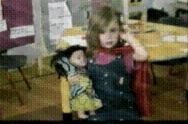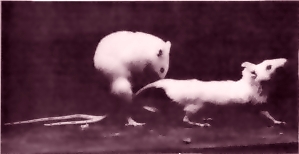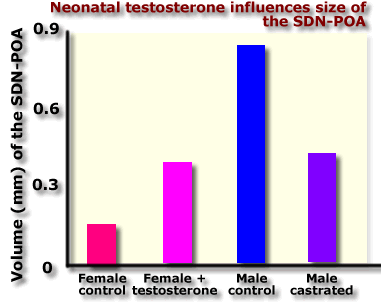
Overview
The contents of this lecture should surprise and, I hope, interest you.
The heart of the lecture is a section describing two opposing views on
the development of gender.
Gender consists of three elements:
- gender role:adoption of masculine or feminine behavioral traits that are deemed appropriate or characteristic of a particular sex
- gender identity:a person's private, subjective sense of their own sex
- sexual orientation / preference:erotic desire for people of same or different sex
The widely held view that gender is the result of the nurture we receive as children is contrasted with the idea that gender is influenced with biological factors in our nature. The lecture explores some evidence that supports the latter position.
A series of experiments showing that it is possible to effect the sexual behaviour of animals by manipulating hormones circulating in their bodies during early development is presented.
An important message from these studies is that the mammalian brain and external genitalia tend to develop as female unless they are exposed to androgens in infancy.
This finding has important implications for human development which are
explored by presenting a study that suggests that girls that are exposed
to testosterone in utero exhibit masculine behaviour patterns in adulthood.




 There are two fundamentally different explanations for how gender develops.
Many psychologists believe that gender is the result of environmental
influences, particularly the way we are treated by our parents, guardians,
friends and relatives. According to Dr John Money we are psychosexually
neutral at birth, and our gender is a consequence of the nurture we receive
as children.
There are two fundamentally different explanations for how gender develops.
Many psychologists believe that gender is the result of environmental
influences, particularly the way we are treated by our parents, guardians,
friends and relatives. According to Dr John Money we are psychosexually
neutral at birth, and our gender is a consequence of the nurture we receive
as children.
















 Hormones travel through the cell membrane and bind with intracellular
steroid receptors. This hormone-receptor complex then passes into the nucleus
where it activates mRNA transcription which leads to the production of
proteins. The resulting proteins then leave the nucleus and pass into the
cell cytoplasm.
Hormones travel through the cell membrane and bind with intracellular
steroid receptors. This hormone-receptor complex then passes into the nucleus
where it activates mRNA transcription which leads to the production of
proteins. The resulting proteins then leave the nucleus and pass into the
cell cytoplasm.
 When testosterone travels across the cell membrane it is converted into
estrogen by the enzyme aromatase. The estrogen attaches to a receptor which
takes it into the cell's nucleus where it initiates the production of proteins
based on instructions in the cell's DNA.
When testosterone travels across the cell membrane it is converted into
estrogen by the enzyme aromatase. The estrogen attaches to a receptor which
takes it into the cell's nucleus where it initiates the production of proteins
based on instructions in the cell's DNA. You might wonder if estrogen - produced by the mother's ovaries during
pregnancy - would cause masculinization of a female fetus. But in females
alphafetoprotein captures estrogen so that it cannot cross the cell membrane
and androgenise the female brain.
You might wonder if estrogen - produced by the mother's ovaries during
pregnancy - would cause masculinization of a female fetus. But in females
alphafetoprotein captures estrogen so that it cannot cross the cell membrane
and androgenise the female brain.











 His testicles were surgically removed and an artificial vagina created,
as is done in sex-change operations. John became Joan.
His testicles were surgically removed and an artificial vagina created,
as is done in sex-change operations. John became Joan.
 The result, says Dr Diamond, has often been extolled as the classic demonstration
of how the environment can override nature in forming gender identity.
In fact, he says, it was nothing of the sort; it was a disaster.
The result, says Dr Diamond, has often been extolled as the classic demonstration
of how the environment can override nature in forming gender identity.
In fact, he says, it was nothing of the sort; it was a disaster.

 Despite being raised as a girl, Joan never felt happy. At 12, she was
given oestrogen therapy to complete the conversion to a woman. She grew
breasts, but was never accepted by other girls, nor felt comfortable as
a woman.
Despite being raised as a girl, Joan never felt happy. At 12, she was
given oestrogen therapy to complete the conversion to a woman. She grew
breasts, but was never accepted by other girls, nor felt comfortable as
a woman.

 At 14, she rebelled, confessing to her doctor: "I suspected I was a boy
since the second grade." She was eventually given a mastectomy to remove
the breasts and was given male hormones. At the age of 25, now John once
more, he married a woman who already had children.
At 14, she rebelled, confessing to her doctor: "I suspected I was a boy
since the second grade." She was eventually given a mastectomy to remove
the breasts and was given male hormones. At the age of 25, now John once
more, he married a woman who already had children.






